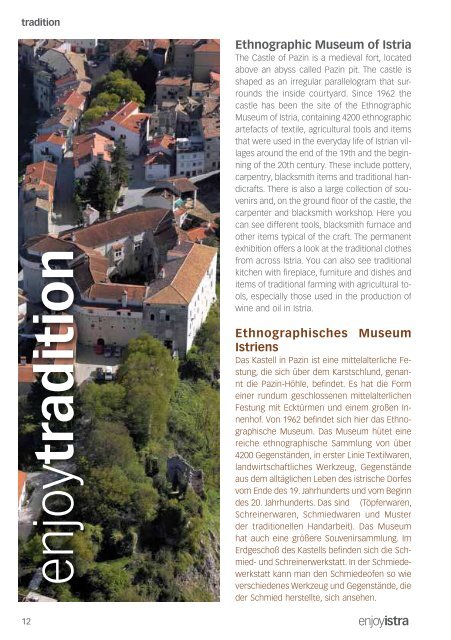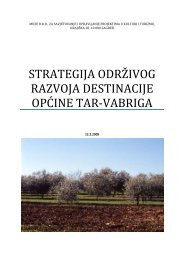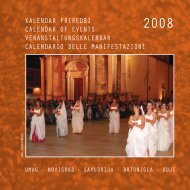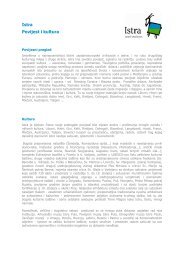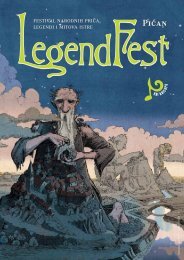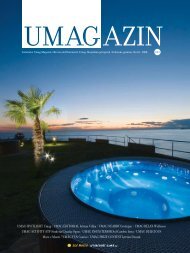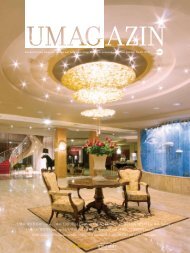enjoyistra
enjoyistra
enjoyistra
Sie wollen auch ein ePaper? Erhöhen Sie die Reichweite Ihrer Titel.
YUMPU macht aus Druck-PDFs automatisch weboptimierte ePaper, die Google liebt.
tradition<br />
tradition<br />
enjoytradition<br />
Ethnographic Museum of Istria<br />
The Castle of Pazin is a medieval fort, located<br />
above an abyss called Pazin pit. The castle is<br />
shaped as an irregular parallelogram that surrounds<br />
the inside courtyard. Since 1962 the<br />
castle has been the site of the Ethnographic<br />
Museum of Istria, containing 4200 ethnographic<br />
artefacts of textile, agricultural tools and items<br />
that were used in the everyday life of Istrian villages<br />
around the end of the 19th and the beginning<br />
of the 20th century. These include pottery,<br />
carpentry, blacksmith items and traditional handicrafts.<br />
There is also a large collection of souvenirs<br />
and, on the ground floor of the castle, the<br />
carpenter and blacksmith workshop. Here you<br />
can see different tools, blacksmith furnace and<br />
other items typical of the craft. The permanent<br />
exhibition offers a look at the traditional clothes<br />
from across Istria. You can also see traditional<br />
kitchen with fireplace, furniture and dishes and<br />
items of traditional farming with agricultural tools,<br />
especially those used in the production of<br />
wine and oil in Istria.<br />
Ethnographisches Museum<br />
Istriens<br />
Das Kastell in Pazin ist eine mittelalterliche Festung,<br />
die sich über dem Karstschlund, genannt<br />
die Pazin-Höhle, befindet. Es hat die Form<br />
einer rundum geschlossenen mittelalterlichen<br />
Festung mit Ecktürmen und einem großen Innenhof.<br />
Von 1962 befindet sich hier das Ethnographische<br />
Museum. Das Museum hütet eine<br />
reiche ethnographische Sammlung von über<br />
4200 Gegenständen, in erster Linie Textilwaren,<br />
landwirtschaftliches Werkzeug, Gegenstände<br />
aus dem alltäglichen Leben des istrische Dorfes<br />
vom Ende des 19. Jahrhunderts und vom Beginn<br />
des 20. Jahrhunderts. Das sind (Töpferwaren,<br />
Schreinerwaren, Schmiedwaren und Muster<br />
der traditionellen Handarbeit). Das Museum<br />
hat auch eine größere Souvenirsammlung. Im<br />
Erdgeschoß des Kastells befinden sich die Schmied-<br />
und Schreinerwerkstatt. In der Schmiedewerkstatt<br />
kann man den Schmiedeofen so wie<br />
verschiedenes Werkzeug und Gegenstände, die<br />
der Schmied herstellte, sich ansehen.<br />
Fažana’s challenge in the fishing<br />
net of tradition<br />
Die Fažanaer Herausforderung<br />
im Netz einer Tradition<br />
Fažana, 30.04. (17.00)<br />
Famed for its crystal-clear sea the Fažana Channel<br />
connects Fažana and Brijuni. Here on the terra firma<br />
the fishing tradition was mentioned as early as<br />
the Middle Ages and has remained a well-known<br />
theme up to the present day. Fishing boats, dinghies<br />
and batane rocking gently along the two<br />
wharfs in Fažana; boats leaving port in the evening<br />
with their fishing lights and the morning activities<br />
at the waterfront. Fishing is part of the family bond:<br />
even today you can see the diligent women from<br />
Fažana as they clean and mend fishing nets after<br />
the fishermen return from sea. Pilchard, anchovy,<br />
mackerel... This is the most frequently caught fish<br />
in Fažana’s fishing nets! But, fish from Fažana was<br />
exported as well. The regular boat service between<br />
Pula and Trieste also included Fažana as its port<br />
of call, so fish as well as lobsters and crabs “grancevole”<br />
could be taken from Fažana to be served<br />
at banquets in Trieste and Vienna. Within the program<br />
of the Fishing academy Pilchard, an especially<br />
interesting event is the Fažana school of salting<br />
pilchard!<br />
Bekannt für sein klares Wasser, verbindet der Kanal<br />
von Fažana den Ort Fažana mit den Brioni Inseln.<br />
Hier auf dem Festland wird schon im Mittelalter<br />
die Tradition des Fischfangs erwähnt, der durch<br />
Jahrhunderte auch unsere Zeit bestimmt. An den<br />
beiden Molen von Fažana schaukeln kleine Fischerboote<br />
und Barken, Pasare und Batanas, im<br />
überschaubaren Hafen; während des Fischfangs<br />
am Abend und des morgenlichen Stimmengewirrs<br />
an der Riva. Der Fischfang ist ein Teil der familiären<br />
Wechselbeziehung: auch heute kann man die<br />
fleißigen Frauen von Fažana beobachten, die nach<br />
der Rückkehr ihrer Fischer, die Netze säubern und<br />
flicken. Es gab aber auch Fische für die Ausfuhr.<br />
An der Schiffslinie Pula - Triest legten die Schiffe in<br />
Fažana an und lieferten Fisch wie auch Hummer<br />
und Krebse für den Bedarf von Triest und die Tische<br />
in Wien. Im April ist im Rahmen des Programms<br />
der Fischerakademie der Sardelle besonders die<br />
Fažanaer Schule des Einlegens dieses blauen Fisches<br />
interessant.<br />
12 13


